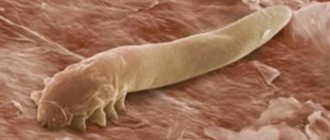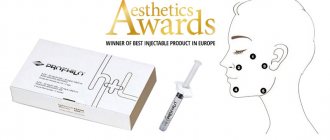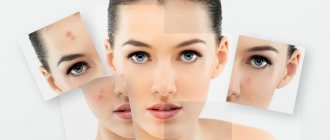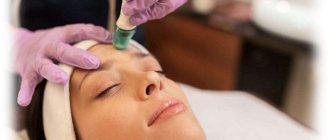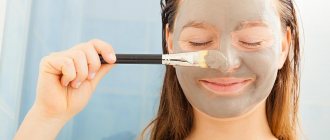- Acne treatment
- Rosacea Treatment
- Treatment of demodicosis
“ Subcutaneous mite ” sounds very unpleasant, and many may think that anyone can get this parasite, but “but not me.”
In fact, demodicosis - this is the name given to damage to hair and skin areas by a microscopic mite - is far from a rare phenomenon. And some cosmetic procedures can provoke an exacerbation.
Scientific fact: human skin can be parasitized by 2 types of Demodex , which feed on dead skin cells and live on the skin and hair follicles, including eyelashes and eyebrows:
- brevis;
- folliculorum.
As a result of their activity, a person feels itchy skin, redness, peeling appear, and the skin becomes rougher. If measures are not taken, all these unpleasant symptoms can develop into crusts and inflammatory elements.
Mite
The subcutaneous mite causes skin lesions in humans and animals - demodicosis. The mite settles in the hair follicles of the head, eyelashes and eyebrows, in the ducts and secretions of the sebaceous glands of the facial skin. A subcutaneous mite is a normal phenomenon, and for the time being it does not pose a danger, since it feeds on waste cells. But if the body’s defenses weaken, the mite begins to actively multiply, penetrates into the deeper layers of the skin and causes inflammation. According to the observations of researchers, women are more often affected by this disease.
FACT:
It is believed that more than 20% of people are carriers of demodicosis, but no clinical signs are detected.
Causes of demodicosis
In a healthy person, the activity of the Demodex mite is suppressed by the body's immune defense. With a decrease in immunity, there are more ticks, which leads to the development of demodicosis. Also, an increase in the number of mites can be caused by metabolic disorders. Demodex feeds mainly on the secretions of the sebaceous glands, so increased productivity of the sebaceous glands leads to the activation of mites and, as a consequence, manifestations of demodicosis.
Thus, the list of the main reasons for the development of demodicosis may look like this:
- decreased general immunity;
- stress factors (stress and negative emotions contribute to decreased immunity);
- chronic diseases leading to a decrease in the protective ability of the skin;
- increased skin oiliness;
- hormonal changes (in particular during adolescence, when as a result of such changes the viscosity of the secretion of the sebaceous glands increases);
- use of cosmetics with hormonal supplements;
- failure to comply with personal hygiene rules.
Signs of illness
In its manifestations, damage to the subcutaneous mite is very similar to rosacea or acne. Peeling of the skin and its redness are noted, itching may occur, constant or worsening after using tonics or washing with cold water. Sometimes there is a combination of demodicosis caused by subcutaneous mites and the above-mentioned skin diseases. And this is not surprising, because the occurrence of demodicosis is influenced by negative changes in the skin. Thus, both acne vulgaris and rosacea weaken the skin’s natural defenses. When affected by skin mites, the following parts of the face are most often affected: eyelids, forehead, chin, nasolabial folds and brow ridges. Exacerbations of demodicosis occur in autumn and spring.
Risk factors
As mentioned above, what is unpleasant is not the presence of a subcutaneous mite as such - in itself it cannot harm a healthy person - but demodicosis, which is caused by a mite. If the body is weakened and there are additional risk factors, the tick can settle in the skin for a long time and cause considerable mental and physical damage to its “breadwinner”. Risk factors include:
- dysfunction of the sebaceous glands, changes in the composition of sebum, vascular changes;
- some skin diseases (rosacea, acne, seborrhea);
- long-term use of hormonal corticosteroid ointments;
- adolescence;
- pregnancy;
- stress.
Unfortunately, non-specialists react with unacceptable ease to the appearance of acne on the face and body. The appearance of such problems is attributed to age and ordinary acne, which sooner or later should disappear on their own. We have to disappoint you: demodicosis caused by subcutaneous mites will not go away on its own. The disease can travel from one area of the skin to another, existing for years and ruining the life of its “donor”.
IMPORTANT:
squeezing out acne when infected with a subcutaneous mite only leads to an exacerbation of the infection, since during this process the mites are pressed into healthy areas of the skin and infect them.
Make an appointment
Oily skin
Oily facial skin: what to do?
There are 4 skin types. Among them, oily facial skin causes the greatest number of problems, since it is characterized by a number of negative signs. Most often, patient dissatisfaction is caused by such characteristic signs as greasy shine, the presence of enlarged pores, and comedones. In addition, it is with this option that the development of various inflammatory elements is most typical. Cosmetologists know best what to do in cases where oily skin causes concern. It is in their competence to clarify the situation and competently care for oily facial skin.
Causes of oily skin
Increased activity of the sebaceous glands leads to the appearance of excessive oily skin. The predisposing factors for this are the following:
- Heredity and individual characteristics;
- Endocrine disorders;
- Non-compliance with the diet;
- Disturbances in the functioning of the gastrointestinal tract;
- Incorrectly selected skin care, low quality cleansing procedures.
Skin type is not a constant value, and in the course of life it can change. Oily skin is more common in young people under the age of 25. In the future, in most cases, it transforms into a combined type. However, in cases where the main causes of oily facial skin are genetic, its clinical signs may persist throughout life. This development of the situation is observed in 5-7% of the population.
Hormonal imbalance is the factor that most influences the increase in oily skin. This process can develop both during puberty and with endocrine pathology. In women, the causes of oily facial skin in adulthood can be polycystic ovary syndrome, insufficient thyroid function, pregnancy, menopause, and uncontrolled use of oral contraceptives. Stress also contributes significantly to the development of symptoms.
Unbalanced functioning of the gastrointestinal tract, especially its manifestations such as constipation, is another prerequisite that affects the increase in oily skin. Poor nutrition, consumption of preservatives, fatty or spicy foods, easily digestible carbohydrates, as well as alcohol and carbonated drinks are also a negative factor.
Characteristics of oily skin
The quality of the skin and excessive oiliness appear unevenly in different areas of the face, which is due to the peculiar distribution of the sebaceous glands in its thickness. It is the accumulation of excretory ducts in certain places that explains the causes of oily skin on the forehead, nose and chin area. Characteristic areas are also located in the back or décolleté area. Often such negative signs are combined with oily hair. In women and men, these signs are usually expressed equally.
Typical manifestations of oily skin are oiliness and a greasy shine. It seems thickened. Excess sebum accumulating on the surface contributes to clogging of pores, their expansion, the formation of blackheads, comedones, and whiteheads, milia. Externally, oily skin on the forehead, nose and chin area resembles an orange peel.
Such signs have a negative effect not only on aesthetics. Oily skin of the forehead and other areas of the T-zone becomes the most preferred location for the localization of inflammatory elements, acne. This is explained by the fact that the narrow duct of the sebaceous gland and the production of an excess amount of secretion contribute to blockage of the excretory ducts of the glands, stagnation of secretion in it and infection. As a result, pustules with purulent contents appear. What to do if oily skin on the forehead is accompanied by the formation of pustular elements, a dermatologist will clarify. It is within his competence to prescribe treatment for acne. The services of a cosmetologist will be in demand only after the inflammatory process has subsided.
However, oily skin also has a number of positive signs. It is more capable of retaining moisture than dry. In this regard, its turgor remains at the same level. Much later, people with oily skin develop wrinkles.
Features of oily skin care
If your facial skin is very oily, a cosmetologist will most competently explain what to do and how to improve its quality. It should be taken into account that incorrect measures, even the use of exclusively external means, can aggravate the situation. The lack of a competent approach in this case may be ineffective or dangerous. You need to trust the professionals. A qualified cosmetologist will select appropriate facial skin care products. If additional procedures are needed to achieve the desired effect, he will carry them out competently. The doctor’s actions in this case should be aimed at reducing the production of sebum and removing its excess, cleansing the pores.
At home, this effect can be achieved by the following steps:
- Thorough cleansing of the skin using foam, gel or mousse for oily skin. To get the desired effect, it is recommended to carry out the procedure twice a day;
- Excluding actions that promote the activity of the sebaceous gland and the formation of excess sebum. These include frequent scrubbing procedures, the use of hot water and a washcloth for washing, the use of fatty cream, and alcohol-containing tonic;
- Normalization of the diet, excluding foods that have a negative impact on the quality of the skin.
An important step towards correcting existing deficiencies is to find out the causes of excess oily skin. In this regard, in addition to the measures prescribed by the cosmetologist, it would not be amiss to consult an endocrinologist and gastroenterologist. It is in their competence to give recommendations on what to do if oily facial skin is caused by concomitant diseases. In some cases, without appropriate treatment, it will not be possible to achieve a lasting improvement in the situation. The required result will be achieved only with an integrated approach.
Of great importance in the fight against the negative signs that accompany oily skin is the correct choice of cosmetic products for daily care. They should all be designed for oily skin, absorb quickly, leaving no shine. Preference is given to a delicate consistency and liquid structure.
In such a situation, it is recommended to scrub the skin 1-2 times a week. It would be optimal to use a film mask as a cleansing procedure, which will most carefully remove dead cells from the surface layer of the dermis. Masks with anti-inflammatory, sebum-regulating, and keratolytic properties are also recommended.
Cosmetologists define what to do if your facial skin is too oily:
- In addition to regular home care, salon cleansing procedures are recommended;
- It is necessary to adhere to the diet;
- Comprehensive examination by related specialists regarding concomitant pathology.
Salon treatments for oily skin
Salon treatments are more effective than care provided at home. By normalizing the functioning of the sebaceous glands, they can improve the quality of the skin and reduce its oiliness in a shorter time. In this case, experts recommend the following measures:
- professional care for oily skin;
- cleansing procedures, cleansing, peeling;
- hardware techniques, ultraphonophoresis, darsonvalization;
- injection procedures, mesotherapy, biorevitalization;
- facial massage, which, by improving microcirculation in the facial area, helps normalize the functioning of the sebaceous glands;
- cryomassage procedure aimed at narrowing pores.
Facial skin cleansing activities are carried out by using external products, applying a cleansing mask, as well as peeling and cleansing. In this case, depending on predisposing factors, ultrasonic, mechanical, and chemical facial cleansing can be used.
Despite the emergence of more innovative means, it is with the help of manual manipulation and a special spoon that it is often possible to get rid of all blackheads during one session. Other procedures, although less traumatic, do not allow obtaining such a quick and pronounced result. However, during mechanical cleaning it is possible that areas of hyperemia may appear, so before important events in the client’s life, specialists give preference to ultrasonic cleaning.
Among procedures aimed at eliminating excess oily skin, all-season peels are very popular. A special role is given to enzymatic peeling, the activity of which is ensured by enzymes. They destroy the substance that holds the horny scales, thereby promoting their independent exfoliation. The gentle effect and the absence of mechanical forces during the procedure ensure its safety and allow peeling not only in the salon, but also at home.
Here are a few questions that our clinic clients most often ask us.
Is it necessary to use moisturizer if you have oily skin?
Although oily skin loses moisture less rapidly than dry skin, it should also be hydrated.
A sufficient amount of hyaluronic acid, thermal water and other hydrofixatives in the composition of external products ensures the process of renewal of the epidermis. Thus, the necessary cleansing effect is achieved and the appearance of oily skin is reduced. How to deal with oily shine throughout the day?
In order to mask the greasy shine as efficiently as possible, you need to choose the right choice of both medicinal and decorative cosmetics.
Care products should be designed for oily skin and have a delicate texture. If possible, cleansing the skin should be done at least 2 times a day. Foundations and shadows should be powdery in nature with a mattifying effect. Creamy cosmetics will only emphasize the signs of oiliness. How to wipe your face if you have oily skin?
Cold water helps to tone oily skin and narrow pores, so some improvement can be achieved by rubbing the skin with ice cubes. The cosmetics industry is also replete with tonics designed for oily skin. The absence of alcohol in them eliminates the increase in the activity of the sebaceous gland. At the same time, they contain extracts of plant herbs that have a mattifying effect.
Treatment
Treatment of demodicosis caused by subcutaneous mites is a long and difficult process. Its complexity is that often this disease develops against the background of a decrease in the body’s defenses and has accompanying skin problems. Therapy tactics include suppressing the parasite, treating underlying diseases and increasing immunity.
The most commonly used local therapy is lotions and special ointments. In more severe cases, the doctor prescribes a course of antibiotics in combination with external therapy. Sometimes plasmapheresis procedures are recommended. In special cases, even surgical intervention is possible.
An important point in the course of treatment is diet. It is necessary to exclude hot, spicy and salty foods, foods rich in carbohydrates and fats from the diet. Those who are being treated for subcutaneous mite infestation are recommended to consume large amounts of fruits, vegetables, microelements, fiber, and dairy products. During treatment, you should not use face masks, especially those containing honey. You need to limit your exposure to the sun. You should also wait until better times to visit the bathhouse and sauna.
